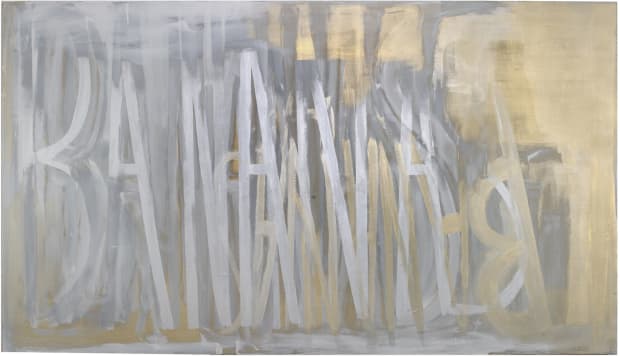-
-
Image: Dana Frankfort, Dana Maurine Frankfort (detail), 1995, oil on panel, 24 x 48 inches. Photograph © Dana Frankfort
-
ALG: How do words function for you? A friend of mine, Michael Miller, who also used text in his paintings, described words as “lines with verbal skills.” Does that resonate with you?
DF: That definitely resonates with me. Words function for me in two ways. They are lines coming together to make linguistic meaning, and words can also fall apart back into being just lines. I’m most interested when an image teeters on this edge of being an abstraction (a series of lines) and a series of lines that take on linguistic meaning (a word).
-

Rene Magritte, The Treachery of Images (This is Not a Pipe), 1929
Image: Los Angeles County Museum of Art
© C. Herscovici/Artists Rights Society (ARS), New York
-

Dana Frankfort, BANANAS (BANANAS), 2008
Image: Inman Gallery © Dana Frankfort
Courtesy of The Museum of Fine Arts, Houston1 -
ALG: How did growing up in Houston lead you into painting? Did The Rothko Chapel have an impact on your work? I ask since many of your paintings seem to belong to very defined series, cyclical in nature, even though you eschew the monumental presence of Mark Rothko’s canvases.DF: Growing up in Houston in the 1970s and ’80s shaped my aesthetic for color and surface, and light and landscape. I also believe it’s where I had my first taste of the monumental: neon billboards against the big Texas sky. And there’s no zoning in Houston, so residential living up against commercial spaces allowed me to see a kind of beauty in that jarring juxtaposition.
-

Mary Heilmann, Hawaiian Planet Study (detail), 2008, oil on canvas, 18 x 24 inches
Image credit: artcritical
-

-
ALG: However, looking around the current body of work, it strikes me that you are ushering text out of the room—it resonates still in certain paintings, but more in the form of pattern recognition than content.
DF: It’s being ushered out but it’s refusing to leave. The text is declarative in some paintings and in other paintings it reverberates.
-
-
-
ALG: How do you achieve the scumbled surfaces of these works?
DF: Layering, viscosity, transparency, touch. A few of these paintings were started and completed within 2022; however, most of the paintings in this show were started years ago, some as long as five years ago. The paintings have been through many stages, and while they appear quick and gestural, I am spending a considerable amount of time looking at—reading—each one. Returning and reworking.
ALG: You also make some truly diminutive paintings. Why?
DF: I approach small paintings in the spirit of “drawing,” in that they are low risk and disposable. I can get in and out of them quickly, and if I hate something I can paint over it or throw it in the trash.
-
ALG: I recognize some color combinations that have run through your work in the past, for example the seductive red/purple hues of one of the PAINT canvases. But other paintings are executed with much more liminal colors, which seems to me to be something of a new direction to me.
DF: Lately I've become more interest in color that's slower - like you see in Giorgio Morandi's meditative still lifes. I am also interested in what happens when saturated colors are layered to create brown, like the pours in a Morris Louis Veil painting.
-

-
"These paintings are slow and require sustained looking. They lean heavily into the language of painting, perhaps as a retreat. Or a protest."
ALG: Can you place these meditative works in the context of the past two years of retreat and isolation?
DF: For me, the past two years have been about introspection. These paintings are slow and require sustained looking. They lean heavily into the language of painting, perhaps as a retreat. Or a protest.
ALG: Are you willing to talk about your daughter Ruthie? Are you ever painting with her in mind as your audience?
DF: I love talking about Ruthie! She’s influenced me in so many ways, starting with her ability to slow down and deeply explore what interests her. I don’t know that I’m painting with her in mind as an audience, but since I am fortunate enough to experience the world through her eyes, I have to believe that her view is manifested in some way in these paintings -
ALG: And finally, I have to ask, And Jugs Paint Reuse? Why? What’s this about?
DF: The title calls attention to the fact that the paintings are made independently but hang as a group. I have started to think about individual word paintings in relationship to sentences/rhetorical arguments/parts of the larger system of language.
For example, the word “Paint” names the action and also suggests that thinking about the language of painting is a worthy pursuit. I hope the title allows for more layers of meaning, and starts to point towards the way context allows individual words to communicate complex ideas.
ALG: And then how did the single canvas titled Effect sneak into this show?DF: There’s the cause and then there’s the effect. -

-
Notes
1. The Museum of Fine Arts, Houston, museum purchased funded by an anonymous donor, Kerry F. Inman and Denby Auble, Sandy Baum, Lester Marks and Dr. Penelope Gonzales, Cheryl and Stephen H. Golub, Velva G. and H. Fred Levine, Minnette and Jerome Robinson, Bruce and Shirley Stein, Joseph and Joyce Chesnick, Arnold and Candace Lipp, the Paula and Irving Pozmantier Philanthropic Fund of the Houston Jewish Community Foundation, Joyce Proler Schechter, Mr. and Mrs. Richard Stein, Clinton T. Willour, and Helen Dow, 2008.387
Alison de Lima Greene is the Isabel Brown Wilson Curator of Modern and Contemporary Art at the Museum of Fine Arts, Houston.
Dana Frankfort is an artist and Associate Professor of painting at the University of Houston. She lives and works in Houston, TX.
Dana Frankfort & Alison de Lima Greene: A Conversation
Past viewing_room
















